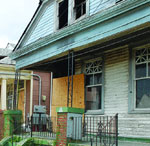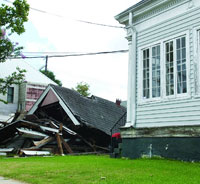Rebuilding New Orleans
Robert and Grisela Jackson in their church's neighborhood on Marengo Street, an area that received close to six feet of flood waters due to the breaks of the federally built levees.
“Home is not what it used to be. You can’t go back, because we haven’t fixed what’s broken there — and we’re not fixing it. Right now we don’t have a plan to fix it. Folks are literally dying of broken hearts,” says Robert Jackson ’77.
A native of New Orleans, Jackson navigates down the “strip” of East New Orleans with his wife, Grisela Alejandro Jackson ’78, pointing to the landmarks left behind by Hurricane Katrina: a rusted overturned car, handwritten street signs, empty shells of vacant shopping centers that had been bustling centers of commerce.

Robert and Grisela Jackson see post-Katrina New Orleans as a chance to contribute personally to building a better city. Grisela says, “It’s a crisis, and it’s an opportunity to turn things around — to reconnect, to get back to the values that are really important.” The couple’s work takes a multifaceted approach to rebuilding that touches many of the most dire needs of the community — from Robert’s role as director of community and intergovernmental relations for the New Orleans Sewerage and Water Board and his spiritual role as pastor of the Historic Second Baptist Church, to Grisela’s efforts to start a charter school and in the process revive a former city school building that has been boarded up and empty since Hurricane Katrina.
“New Orleans is a born-here, live-here, die-here kind of city,” Robert says, his fleur-de-lis — the city’s emblem — cufflinks gleaming as he gestures. Many people have lived in New Orleans for generations, he says, and never thought they would move from the city, despite the tremendous risk posed by hurricanes. Yet a 2006 Census Bureau estimate places the city’s population at 223,400 — less than 50 percent of what it was before Katrina. In some of the most devastated areas, that percentage is far lower. Robert says he is embracing his pride in New Orleans more now than ever before. “You don’t want to just remind yourself that you’re still here; you want to remind others that you’re still here, and that you’re proud you’re still here, and that you’re still hopeful.”
In Robert’s role with the Sewerage and Water Board, he is classified as a first responder, which means he could not evacuate as the storm struck. Before the hurricane, he fielded media requests about the city’s emergency preparedness. In the immediate aftermath of the storm, he worked to assess the damage in order to provide the media with answers on the spot. He says, “Before you even had relief efforts really launched, you had more media land in the city than anything else.” His job then became one of negotiator, communicating with state and federal government about the city’s water needs. Among other things, the Sewerage and Water Board was responsible for making sure pumping stations were operable, getting potable water to FEMA and rescue workers, repairing leaking pipes, and keeping the city’s water pressure steady.

For the next four months Grisela lived in Houston, where she focused on making sure Anna, a high-school senior, would be able to graduate on time and go to college as planned. And Jedidiah finished his final college credits online so that he too could graduate on time. Robert, meanwhile, slept on an air mattress at an emergency response center in Baton Rouge, Louisiana, and commuted to work in New Orleans daily — more than 90 miles in each direction. He also continued to perform his duties as pastor of the Historic Second Baptist Church, holding Thanksgiving Day service in a hotel banquet room in Houston, where many church members had relocated, and regular Sunday services at a funeral parlor in Baton Rouge.
View interviews with Robert Jackson ’77 and Grisela Alejandro Jackson ’78.
Windows users try these links

The Jacksons visit their former church (Flash version)
A drive through New Orleans (Flash version)
Grisela Jackson discussing education (Flash version)
Macintosh users try these links
The Jacksons visit their former church (Quicktime version)
A drive through New Orleans (Quicktime version)
Grisela Jackson discussing education (Quicktime version)
Videos created by Ben Kalina ’98
